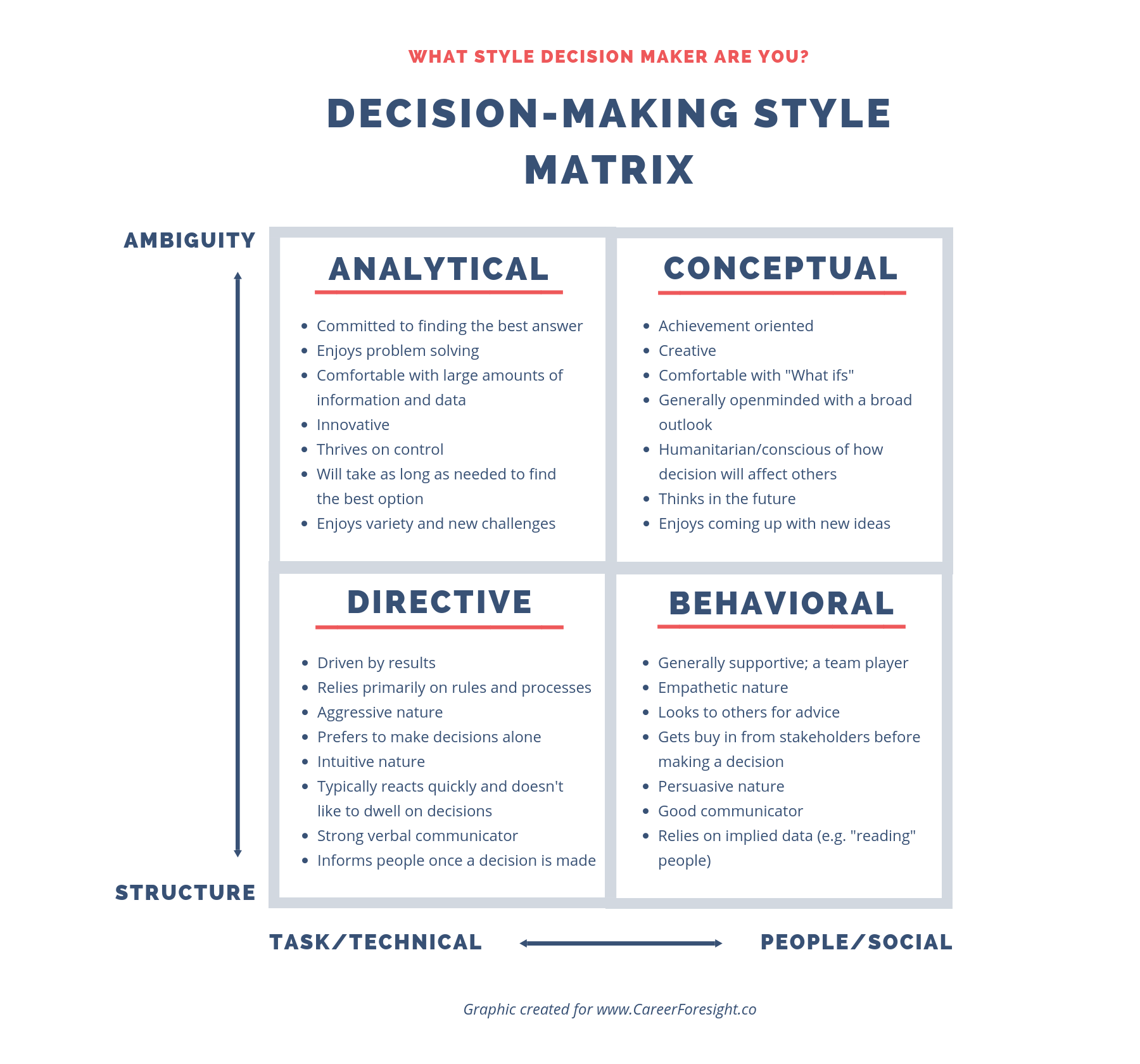Understanding the 4 Styles of Decision Making (For Your Big Life Decisions)
Big life decisions can be very emotional and stress-inducing.
Often, it feels like big decisions, primarily related to our careers, will either make or break our future success.
That leads to significant amounts of pressure.
While some people may perform well under pressure, pressure doesn't help anyone navigate the decision-making process better.
Whether you're considering making a career change, starting a new passion project or relocating, learning more about what's happening behind-the-scenes as you process a decision will help you gain more control and clarity in times of uncertainty.
Most decision-making resources and tools focus on group decision making. For example, how to make decisions from a corporate leadership perspective. While you can undoubtedly glean information about how to make decisions for yourself from those models, I wanted to provide a more accessible tool to help you confidently process the choices that impact your personal life most.
What are the four styles of decision making?
You can think of decision-making styles as something similar to personality types. If you love the Enneagram or the Myers Briggs personality tests, then you're apt to love this as well. However, I do want to clarify that this is not a personality test.
Instead, it is a tool to give you insight into how you process your decisions. The goal is to help you recognize your strengths and weaknesses so that you can become a stronger, more confident decision maker.
The four decision-making styles include:
How are the decision-making styles determined?
Two spectrums work together to create the decision-making style framework. The first spectrum is structure vs. ambiguity. This spectrum measures people's propensity to prefer either structure (i.e., defined processes and expectations) or ambiguity (i.e., open-ended and flexible).
The second spectrum is task/technical vs. people/social. This spectrum measures if the motivation to make a specific choice is guided more by a desire to be right, or to get results (task/technical), or if it's to create harmony or social impact (people/social).
Where you fall on both of these spectrums will determine which quadrant best describes you. Each quadrant relates to a decision-making style, as you can see below.
Analytical Style Decision Making
Analytical style decision making describes people who feel comfortable with ambiguity but are motivated to find the best or most comprehensive solution.
If you are an analytical style decision maker, you likely take a long time to process big life decisions. Your comfort with ambiguity doesn't mean that you are a risk-taker or would be likely to decide without knowing how it would work out. That would stress you out a lot!
Instead, your comfort with ambiguity means that you enjoy considering all options before making a decision. You think of creative solutions and are willing to give most prospects a chance. However, you only like to move forward once you are as close to certain as possible that that choice is best.
While making responsible decisions is a strength of analytical style decision-makers, their weaknesses tend to be making timely decisions, communicating with others and managing stress during the decision-making period.
Directive Style Decision Making
Directive style decision making describes people who prefer structure and are motivated by the results their decisions will bring them.
If you are a directive style decision maker, you likely make decisions quickly and have a "decide and move forward" mentality. You don't like dwelling in possibility and prefer to take action.
To help you make decisions quickly, you tend to rely on case studies and rules to tell you how to move forward. You think that "reinventing the wheel" is a waste of time and that applies to your personal decisions as well.
One of your dominant strengths is your communication skills. You convey confidence, purpose and a sense of concreteness in your decisions that others admire. This confidence helps you gain support and trust for the choices you make.
However, directive style decision-makers tend to struggle with receiving advice, responding to differing opinions and creating a plan in new or uncertain situations.
Conceptual Style Decision Making
Conceptual style decision making describes people who enjoy the ambiguity of open-ended options and are motivated to make an impact on the world.
If you are a conceptual style decision maker, you likely day-dream often and quickly come up with creative ideas when needed. You see how most things connect and affect each other. You desire to come up with holistic solutions.
Your comfort in ambiguity helps you to think bigger, and feel more hopeful that your ideas will work out, than people with other decision-making styles.
Your strengths are recognizing underlying problems and coming up with creative, integrated options to pursue.
But many conceptual style decision-makers find their weaknesses tend to be taking action on a decision, adequately planning for what a choice will involve and follow-through.
Behavioral Style Decision Making
Behavioral style decision making describes people who prefer structure and stability and are motivated to maintain harmony.
If you are a behavioral style decision maker, your relationships are probably the most important thing in your life. You are likely to put the needs and opinions of family, friends, and colleagues above your own.
It may seem difficult to balance the desire for structure and other people's thoughts and feelings, but behavioral style decision-makers accomplish this by seeking input and gauging reactions from people in the decision-making process.
They use the information they gather to come up with solutions that they believe others will respond well to and typically ask for advice before moving forward with a decision.
The strengths of behavioral style decision-makers are, most notably, their ability to make others feel included and important, getting buy-in from others and communicating their decisions.
However, their weaknesses are not trusting themselves and difficulty dealing with conflict. Behavioral style decision-makers can easily lose themselves in the advice and opinions of others. They may be called "people pleasers." Conflict is challenging for them to manage. To avoid it, they sometimes take on unnecessary amounts of responsibility and stress.




